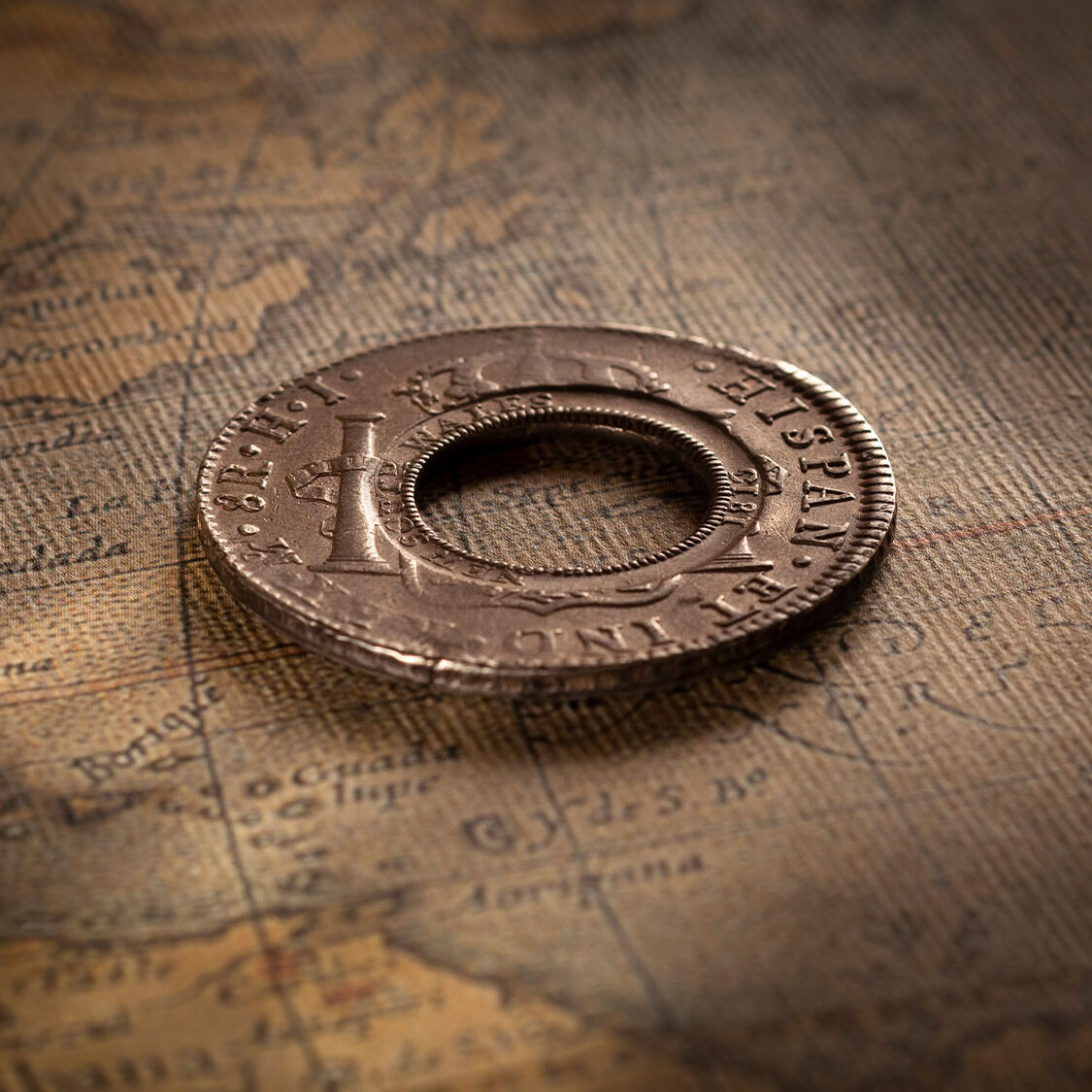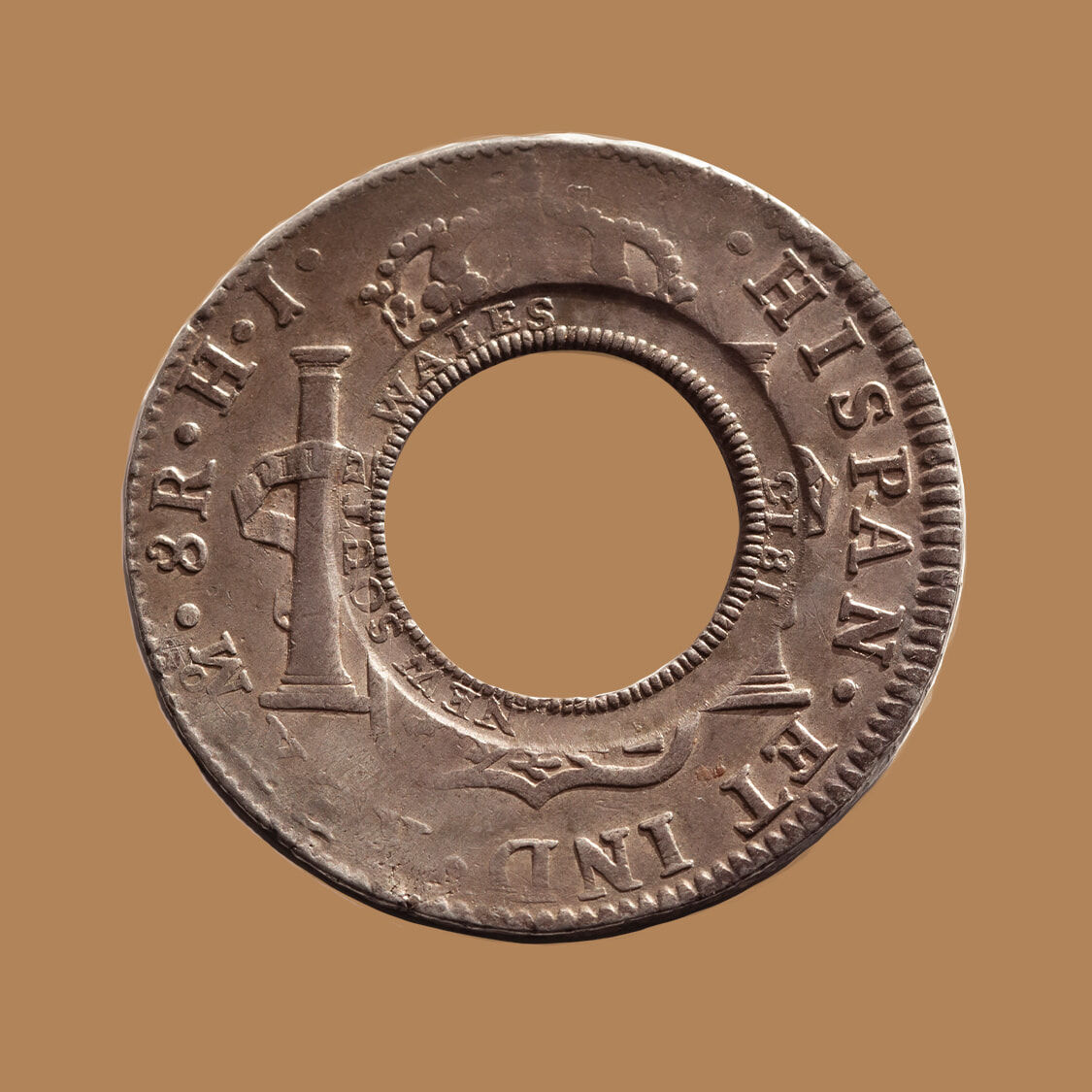1813 Holey Dollar created from an 1809 Ferdinand VII Spanish Silver Dollar


The fundamentals of this Holey Dollar.
When William Henshall created this Holey Dollar, he grabbed a Spanish Silver Dollar that had been struck in 1809 at the Mexico Mint and that depicted the legend and portrait of King Ferdinand VII of Spain.
Had Henshall been an avid historian he might have realised that Joseph Bonaparte was King of Spain in 1809. Ferdinand was definitely NOT the reigning monarch. So, the dollar he was about to deface, had an extreme historical peculiarity and rarity that might have made it worth holding onto.
But Henshall was our first mint master and was committed to the task of creating the nation's first coins. Using crude equipment, he cut a hole in the dollar.
The Ferdinand VII silver dollar that Henshall was handling was one of 40,000 coins that he would eventually deface in his quest to create the nation's first coin.
Henshall then continued the minting process by over-stamping the inner circular edge of the hole with the words New South Wales, the date '1813' and the value of five shillings.
And it is at this point - the over-stamping involving the application of the date, value and issuing authority - that the holed silver dollar became the 1813 New South Wales Five Shillings. Better known as the 1813 Holey Dollar.
A Holey Dollar that is defined by the monarch Ferdinand VII.
Lachlan Macquarie's shipment of 40,000 Spanish Silver dollars was not specific, so any date would do. And any monarch would suffice, Charles III, Charles IV, Ferdinand VI or Ferdinand VII.
And herein lies the key! For some monarchs appear more frequently than others.
Holey Dollars featuring the portrait of Charles IV are the most readily available, followed by Charles III, and Ferdinand VII. A Ferdinand VI Holey Dollar does exist but it is unique and is definitely not for sale.
So the rarest monarch from a collector's perspective is Ferdinand VII with only thirteen Holey Dollars available to private collectors.
A Holey Dollar that has quality, both in the original dollar and the counter-stamps.
The original 1809 Spanish Silver Dollar from which this Holey Dollar was created is graded in the premium quality levels of About Extremely Fine indicating that it underwent slight circulation before the hole was cut into it in 1813.
The surfaces are glossy and highly reflective. Remarkable when you consider that Spanish Silver Dollar was at the time the world’s greatest trading coin.
Whoever was mint master during the Ferdinand VII period certainly had his eye off the ball, for many of the Ferdinand Holey Dollars show a weakness in the striking of the original Spanish Dollar. And the weaknesses are noted in even the best examples. It is important to note that a weakness in the strike is different from wear and tear. It just reflects the skills of the minting staff!
The extent of usage of the Holey Dollar after it was released into circulation is evidenced by the wear to the counter-stamps, the over-stamping around the inner circular edge … New South Wales, 1813 and Five Shillings.
The counter-stamps of this Holey Dollar are also graded in the premium quality levels of Extremely Fine, which indicates that as a Holey Dollar, the coin underwent minimal usage.
In summary, this Holey Dollar was created in 1813 by mint-master William Henshall. Officially demonetised in 1829 when most of the coins were sent to the melting pot. So by some fluke, this Holey Dollar avoided the melting pot and was barely used in the interim.
And doesn't it show? We rate this coin as being in the top five of the thirteen surviving privately owned Ferdinand VII Holey Dollars.
The chart below clearly shows the spread of Holey Dollars based on quality. And the relative ready availability of low-quality examples. The chart also confirms the extreme rarity of high-quality specimens.


The original Spanish Silver Dollar features the legend and portrait of King Ferdinand VII of Spain. The counter-stamps are comprised of 'FIVE SHILLINGS', a double twig of leaves with an 'H' for Henshall at the junction and a fleur de lis. They are all crisp and clear and are graded Extremely Fine.

The 'M' with a circle above it in the legend identifies the dollar as being issued from the Mexico Mint. The counter-stamps New South Wales, 1813 and Five Shillings are graded Extremely Fine.
A Holey Dollar with a Bonaparte connection.
Napoleon Bonaparte emerged as the strongman of Europe in 1799 leading his armies across Europe deposing monarchs and dominating the entire continent. At the time Spain was ruled by King Charles IV and Spain was an ally of France.
In 1807, Bonaparte’s armies marched through Spain and invaded Portugal.
The alliance between France under Bonaparte and Spain under Charles IV disintegrated the following year when on February 16, 1808, under the pretext of sending reinforcements to the French army occupying Portugal, the French invaded northern Spain.
King Charles IV was pressured into abdicating the Spanish throne in March 1808 to his son Ferdinand VII. The son reigned for less than two months.
Both Charles IV and Ferdinand VII were duped by Napoleon Bonaparte into ceding the Spanish throne to Bonaparte’s older brother Joseph who assumed rule of the Spanish kingdom on 6 June 1808.
And while the upper echelons of the Spanish Government accepted Ferdinand's abdication and Napoleon's choice of Joseph as King of Spain, the Spanish people did not. Uprisings broke out throughout the country.
The Mexico Mint refused to acknowledge Bonaparte as the Spanish King and protested by continuing to strike their silver dollars with the legend and portrait of the exiled Ferdinand VII. It’s politics 101. Played out in the nineteenth century.
By 1813 the French position in Spain became untenable and Napoleon withdrew his troops and released Ferdinand VII from Valencay, France, where he had been imprisoned. Ferdinand VII returned triumphantly to Madrid and re-claimed the Spanish crown early in 1814.
© Copyright: Coinworks
